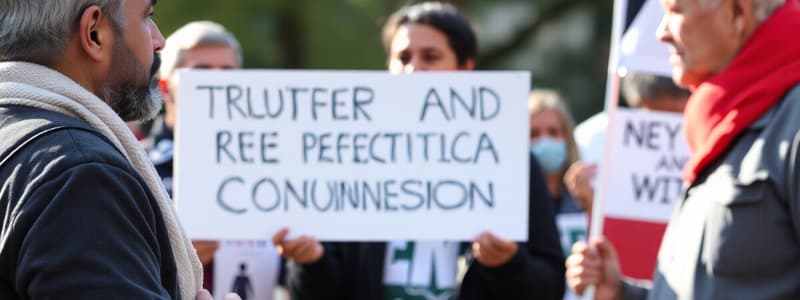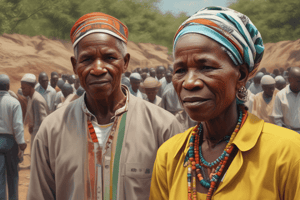Podcast
Questions and Answers
What is the intention behind the 'Calls to Action' regarding early childhood and education?
What is the intention behind the 'Calls to Action' regarding early childhood and education?
- To ensure Indigenous children have access to quality education and care that respects their unique experiences and identities.
- To promote Indigenous languages and traditions in educational settings.
- To encourage the integration of Indigenous perspectives and knowledge into education systems.
- All of the above. (correct)
Which of the following organizations is responsible for monitoring and reporting on Canada's progress in implementing the 'Calls to Action'?
Which of the following organizations is responsible for monitoring and reporting on Canada's progress in implementing the 'Calls to Action'?
- The Yellowhead Institute (correct)
- The United Nations Declaration on the Rights of Indigenous Peoples (UNDRIP)
- The Truth and Reconciliation Commission of Canada (TRC)
- The Indigenous Early Learning and Child Care (IELCC) Framework
What is the primary focus of the United Nations Declaration on the Rights of Indigenous Peoples (UNDRIP)?
What is the primary focus of the United Nations Declaration on the Rights of Indigenous Peoples (UNDRIP)?
- To ensure equitable access to education for Indigenous children.
- To protect and promote Indigenous rights and self-determination globally. (correct)
- To provide a framework for addressing historical injustices against Indigenous peoples.
- To guide the implementation of the Truth and Reconciliation Commission (TRC) Calls to Action.
Which of the following best describes the relationship between UNDRIP and the 'Calls to Action'?
Which of the following best describes the relationship between UNDRIP and the 'Calls to Action'?
What is the key significance of Bill C-262 in relation to UNDRIP?
What is the key significance of Bill C-262 in relation to UNDRIP?
How does UNDRIP pose a challenge to existing practices in Canada?
How does UNDRIP pose a challenge to existing practices in Canada?
Which of the following statements accurately describes the impact of the TRC 'Calls to Action' on ECEC?
Which of the following statements accurately describes the impact of the TRC 'Calls to Action' on ECEC?
How does the IELCC Framework relate to the principles outlined in the TRC and UNDRIP?
How does the IELCC Framework relate to the principles outlined in the TRC and UNDRIP?
What is meant by 'promoting cultural continuity' in the context of ECEC?
What is meant by 'promoting cultural continuity' in the context of ECEC?
Which of the following is NOT a key principle emphasized by both the TRC 'Calls to Action' and UNDRIP?
Which of the following is NOT a key principle emphasized by both the TRC 'Calls to Action' and UNDRIP?
What is the primary objective of the IELCC Framework?
What is the primary objective of the IELCC Framework?
What is the most significant impact of the TRC 'Calls to Action' and UNDRIP on the field of ECEC?
What is the most significant impact of the TRC 'Calls to Action' and UNDRIP on the field of ECEC?
What does the term 'free, prior, and informed consent' mean in the context of UNDRIP?
What does the term 'free, prior, and informed consent' mean in the context of UNDRIP?
How can ECE educators contribute to reconciliation, as it relates to the TRC 'Calls to Action' and UNDRIP?
How can ECE educators contribute to reconciliation, as it relates to the TRC 'Calls to Action' and UNDRIP?
What is the main reason why the TRC 'Calls to Action' and UNDRIP are relevant to the field of ECEC?
What is the main reason why the TRC 'Calls to Action' and UNDRIP are relevant to the field of ECEC?
What was the primary objective of the Truth and Reconciliation Commission (TRC)?
What was the primary objective of the Truth and Reconciliation Commission (TRC)?
When did the last residential school in Canada close?
When did the last residential school in Canada close?
What is the significance of the 94 Calls to Action issued by the TRC?
What is the significance of the 94 Calls to Action issued by the TRC?
What is the main focus of the Legacy section of the Truth and Reconciliation Commission's Calls to Action?
What is the main focus of the Legacy section of the Truth and Reconciliation Commission's Calls to Action?
What is the main message conveyed in the documentary Honour to Senator Murray Sinclair?
What is the main message conveyed in the documentary Honour to Senator Murray Sinclair?
What is the meaning of the phrase 'cultural genocide' as it relates to residential schools?
What is the meaning of the phrase 'cultural genocide' as it relates to residential schools?
What is one way that individuals can contribute to reconciliation?
What is one way that individuals can contribute to reconciliation?
Why is it important to understand the history of residential schools?
Why is it important to understand the history of residential schools?
What is the main goal of the Truth and Reconciliation Commission (TRC)?
What is the main goal of the Truth and Reconciliation Commission (TRC)?
Which of the following is NOT a key theme emphasized by the United Nations Declaration on the Rights of Indigenous Peoples (UNDRIP)?
Which of the following is NOT a key theme emphasized by the United Nations Declaration on the Rights of Indigenous Peoples (UNDRIP)?
How does the IELCC Framework relate to the TRC and UNDRIP?
How does the IELCC Framework relate to the TRC and UNDRIP?
What does the term "cultural genocide" refer to in the context of Indigenous history in Canada?
What does the term "cultural genocide" refer to in the context of Indigenous history in Canada?
Which of the following areas is NOT identified by the TRC's final report as being significantly impacted by the legacy of assimilation policies and residential schools?
Which of the following areas is NOT identified by the TRC's final report as being significantly impacted by the legacy of assimilation policies and residential schools?
What is the primary responsibility ECE educators have, according to the TRC, UNDRIP, and the IELCC Framework?
What is the primary responsibility ECE educators have, according to the TRC, UNDRIP, and the IELCC Framework?
How can educators contribute to reconciliation in early childhood education?
How can educators contribute to reconciliation in early childhood education?
What is the primary goal of anti-bias education in early childhood education?
What is the primary goal of anti-bias education in early childhood education?
What does "culturally appropriate" mean in the context of early childhood education?
What does "culturally appropriate" mean in the context of early childhood education?
Flashcards
Truth and Reconciliation Commission (TRC)
Truth and Reconciliation Commission (TRC)
A commission established to document the harms caused by Canada's residential school system.
Indian Residential Schools
Indian Residential Schools
Government-run schools where Indigenous children were forcibly placed and culturally assimilated.
94 Calls to Action
94 Calls to Action
Recommendations from the TRC aimed at addressing the legacy of residential schools.
Cultural genocide
Cultural genocide
Signup and view all the flashcards
Murray Sinclair
Murray Sinclair
Signup and view all the flashcards
Legacy section of TRC
Legacy section of TRC
Signup and view all the flashcards
Survivor stories
Survivor stories
Signup and view all the flashcards
Documentary Honour
Documentary Honour
Signup and view all the flashcards
Residential School Program
Residential School Program
Signup and view all the flashcards
Reconciliation
Reconciliation
Signup and view all the flashcards
United Nations Declaration on the Rights of Indigenous Peoples (UNDRIP)
United Nations Declaration on the Rights of Indigenous Peoples (UNDRIP)
Signup and view all the flashcards
Calls to Action
Calls to Action
Signup and view all the flashcards
Indigenous Early Learning and Child Care Framework
Indigenous Early Learning and Child Care Framework
Signup and view all the flashcards
Anti-Bias Education
Anti-Bias Education
Signup and view all the flashcards
Lifelong Learning
Lifelong Learning
Signup and view all the flashcards
Collaboration with Indigenous Communities
Collaboration with Indigenous Communities
Signup and view all the flashcards
UNDRIP
UNDRIP
Signup and view all the flashcards
Self-determination
Self-determination
Signup and view all the flashcards
Cultural revitalization
Cultural revitalization
Signup and view all the flashcards
Early Childhood Education Actions
Early Childhood Education Actions
Signup and view all the flashcards
Yellowhead Institute
Yellowhead Institute
Signup and view all the flashcards
Equity in Education
Equity in Education
Signup and view all the flashcards
Bill C-262
Bill C-262
Signup and view all the flashcards
Culturally Appropriate Education
Culturally Appropriate Education
Signup and view all the flashcards
Free, prior, and informed consent
Free, prior, and informed consent
Signup and view all the flashcards
Collective rights
Collective rights
Signup and view all the flashcards
Preservation of Languages
Preservation of Languages
Signup and view all the flashcards
Truth and Reconciliation Commission
Truth and Reconciliation Commission
Signup and view all the flashcards
Study Notes
Truth and Reconciliation Commission (TRC)
- Operated from 2008 to 2015, part of the Indian Residential Schools Settlement Agreement.
- Aimed to document the historical harm caused by residential schools.
- Documented the removal of Indigenous children from families, causing immense cultural and social harm.
- The last residential school closed in 1996 in Canada and 1980 in Newfoundland and Labrador.
- Led to 94 Calls to Action for reconciliation and systemic change.
- These calls focus on addressing the lingering effects of these schools.
- Calls to Action address areas like child welfare, education, language, culture, health, and justice.
United Nations Declaration on the Rights of Indigenous Peoples (UNDRIP)
- A global human rights framework for Indigenous peoples.
- Includes 46 articles outlining collective and individual rights.
- Highlights cultural protections, land rights and self-determination in all areas.
- Recognizes the responsibility of governments at all levels to uphold these rights.
- Focuses on Indigenous peoples' survival, dignity, and well-being.
- Key themes include self-determination, distinct recognition, free prior and informed consent, and freedom from discrimination.
Bill C-262
- Aimed at implementing UNDRIP in Canada.
- Became law in June 2021, aligning Canadian laws with UNDRIP principles.
- Presents challenges to existing systems, policies, and practices related to Indigenous land and resources, and infrastructure.
Impact on Early Childhood Education (ECE)
- TRC and UNDRIP provide frameworks for addressing systemic inequities and cultural continuity in ECE.
- Emphasize the importance of respecting Indigenous histories, knowledge systems, and cultural heritage in ECE settings.
- Require educators to work towards reconciliation by addressing past injustices and building respectful relationships.
- Promoting anti-bias education and collaborating with Indigenous communities are crucial aspects.
- Encouraging lifelong learning in understanding Indigenous cultures is vital.
- Critically reviewing existing practices are fundamental to implement these important principles.
Studying That Suits You
Use AI to generate personalized quizzes and flashcards to suit your learning preferences.



